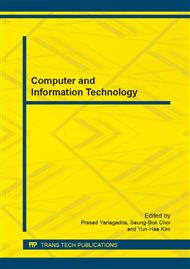p.271
p.275
p.279
p.284
p.288
p.294
p.302
p.309
p.313
Multipath Routing
Abstract:
Multipath routing can be effectively used for maximum utilization of network resources. It gives the node a choice of next hops for the same destination. We present two tree based algorithms, which we call MSPT and MBFT that can help a node to find multiple next hops for a destination. Both of them are distributed algorithm, allowing the traffic to switch off the shortest path and fully exploiting the path diversity of the network. MSPT has lower cost, while MBFT has less hops between the source and destination, end system can select next hop according to the application requirements. The simulation show that our algorithms can find more selectable next hops and have good reliability and fast recovery performance. In the process of simulation, we discovery that MSPT and MBFT have more disjoint paths, therefore we provide an Algorithm 2 to combine the MSPT and MBFT, the performance of Algorithm 2 is obviously superior than independently employs
Info:
Periodical:
Pages:
288-293
Citation:
Online since:
February 2014
Authors:
Keywords:
Price:
Сopyright:
© 2014 Trans Tech Publications Ltd. All Rights Reserved
Share:
Citation:


